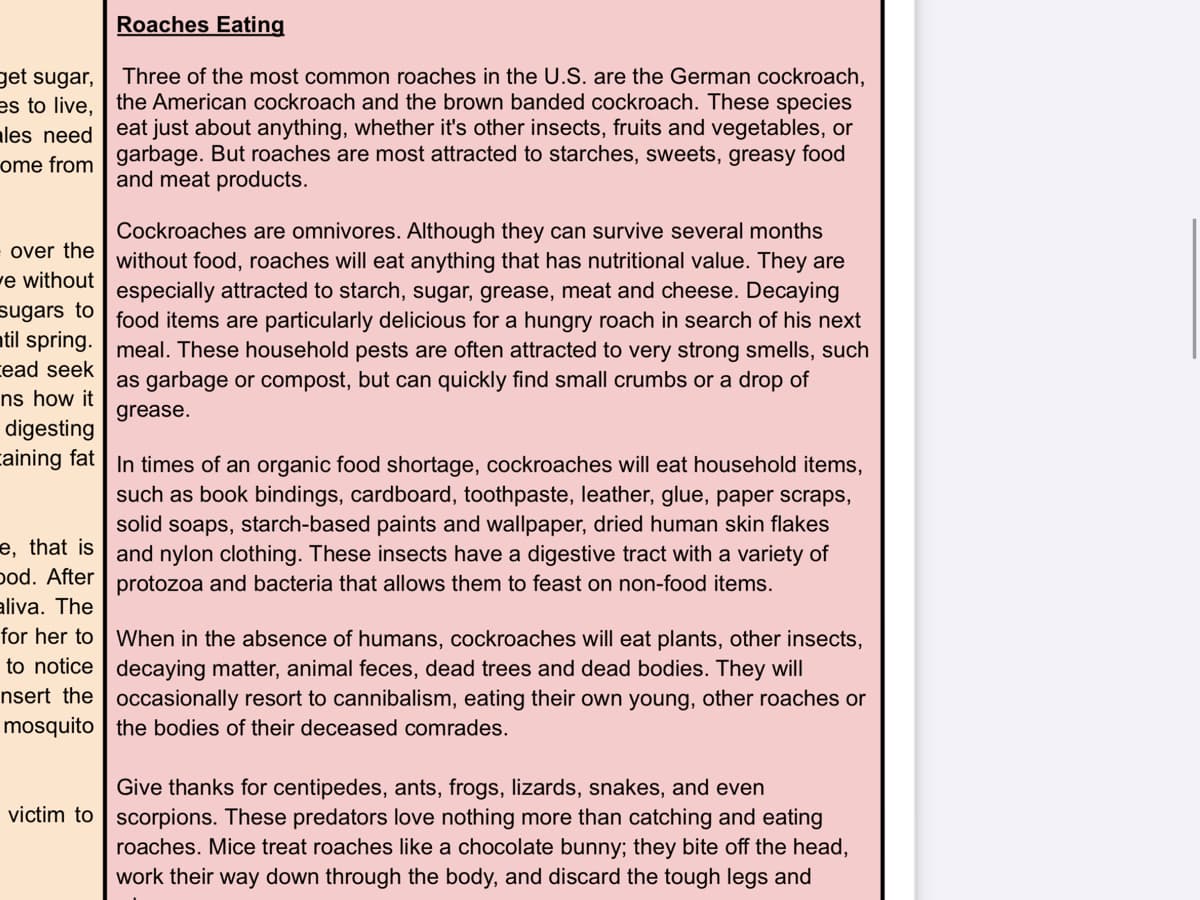1. Identify abiotic factors that support the survival and reproduction of roaches and explain why they need this factors 2. Identify biotic factors that support the survival and reproduction of the roaches and explain why they need this factors 3. Predict what factors in the environment can be altered to decrease the survival and reproduction of roaches and why?
1. Identify abiotic factors that support the survival and reproduction of roaches and explain why they need this factors 2. Identify biotic factors that support the survival and reproduction of the roaches and explain why they need this factors 3. Predict what factors in the environment can be altered to decrease the survival and reproduction of roaches and why?
Biology: The Unity and Diversity of Life (MindTap Course List)
15th Edition
ISBN:9781337408332
Author:Cecie Starr, Ralph Taggart, Christine Evers, Lisa Starr
Publisher:Cecie Starr, Ralph Taggart, Christine Evers, Lisa Starr
Chapter25: Animal Evolution-the Chordates
Section: Chapter Questions
Problem 2DAA: Deathly Lamprey Repellent Predation by sea lampreys on native fishes in the Great Lakes is an...
Related questions
Question
Based on the text on roaches eating:
1. Identify abiotic factors that support the survival and reproduction of roaches and explain why they need this factors
2. Identify biotic factors that support the survival and reproduction of the roaches and explain why they need this factors
3. Predict what factors in the environment can be altered to decrease the survival and reproduction of roaches and why?
PLEASE ANSWER ALL QUESTION BASED ON THE TEXT

Transcribed Image Text:Roaches Eating
get sugar,
es to live. the American cockroach and the brown banded cockroach. These species
Three of the most common roaches in the U.S. are the German cockroach,
eat just about anything, whether it's other insects, fruits and vegetables, or
ales need
ome from garbage. But roaches are most attracted to starches, sweets, greasy food
and meat products.
Cockroaches are omnivores. Although they can survive several months
without food, roaches will eat anything that has nutritional value. They are
especially attracted to starch, sugar, grease, meat and cheese. Decaying
sugars to | food items are particularly delicious for a hungry roach in search of his next
atil spring. meal. These household pests are often attracted to very strong smells, such
over the
ve without
ead seek
as garbage or compost, but can quickly find small crumbs or a drop of
ns how it
grease.
digesting
taining fat In times of an organic food shortage, cockroaches will eat household items,
such as book bindings, cardboard, toothpaste, leather, glue, paper scraps,
solid soaps, starch-based paints and wallpaper, dried human skin flakes
e, that is and nylon clothing. These insects have a digestive tract with a variety of
bod. After protozoa and bacteria that allows them to feast on non-food items.
aliva. The
for her to
When in the absence of humans, cockroaches will eat plants, other insects,
to notice decaying matter, animal feces, dead trees and dead bodies. They will
nsert the occasionally resort to cannibalism, eating their own young, other roaches or
mosquito the bodies of their deceased comrades.
Give thanks for centipedes, ants, frogs, lizards, snakes, and even
victim to scorpions. These predators love nothing more than catching and eating
roaches. Mice treat roaches like a chocolate bunny; they bite off the head,
work their way down through the body, and discard the tough legs and
Expert Solution
This question has been solved!
Explore an expertly crafted, step-by-step solution for a thorough understanding of key concepts.
This is a popular solution!
Trending now
This is a popular solution!
Step by step
Solved in 4 steps

Knowledge Booster
Learn more about
Need a deep-dive on the concept behind this application? Look no further. Learn more about this topic, biology and related others by exploring similar questions and additional content below.Recommended textbooks for you

Biology: The Unity and Diversity of Life (MindTap…
Biology
ISBN:
9781337408332
Author:
Cecie Starr, Ralph Taggart, Christine Evers, Lisa Starr
Publisher:
Cengage Learning

Biology: The Unity and Diversity of Life (MindTap…
Biology
ISBN:
9781305073951
Author:
Cecie Starr, Ralph Taggart, Christine Evers, Lisa Starr
Publisher:
Cengage Learning

Biology: The Unity and Diversity of Life (MindTap…
Biology
ISBN:
9781337408332
Author:
Cecie Starr, Ralph Taggart, Christine Evers, Lisa Starr
Publisher:
Cengage Learning

Biology: The Unity and Diversity of Life (MindTap…
Biology
ISBN:
9781305073951
Author:
Cecie Starr, Ralph Taggart, Christine Evers, Lisa Starr
Publisher:
Cengage Learning